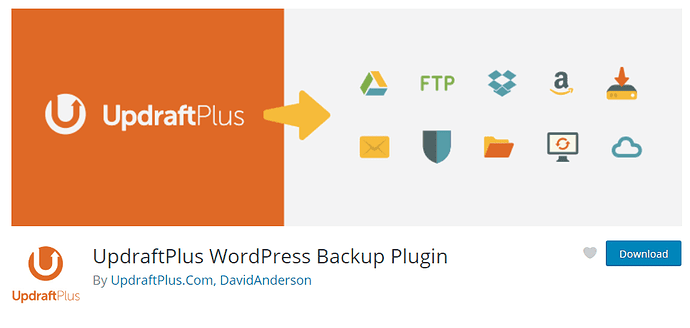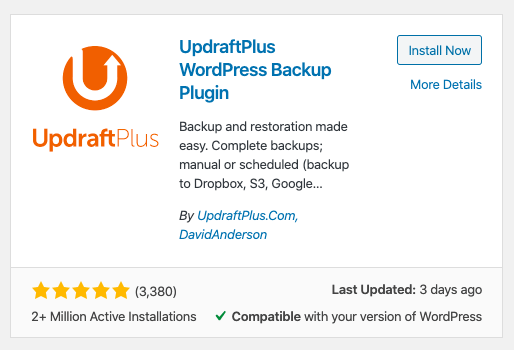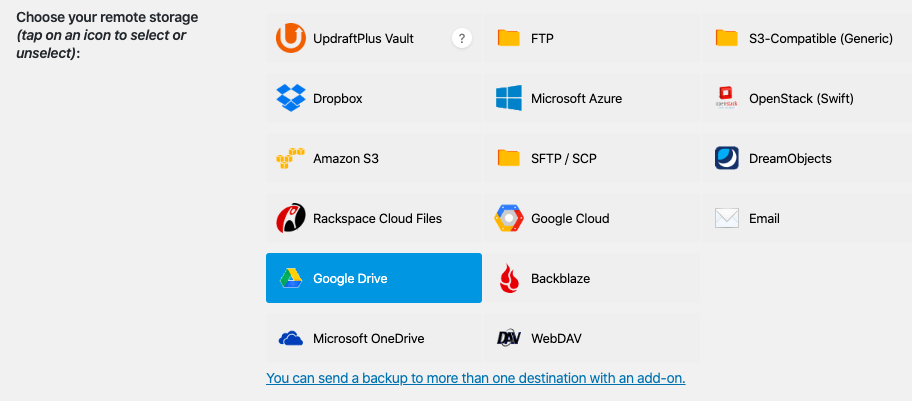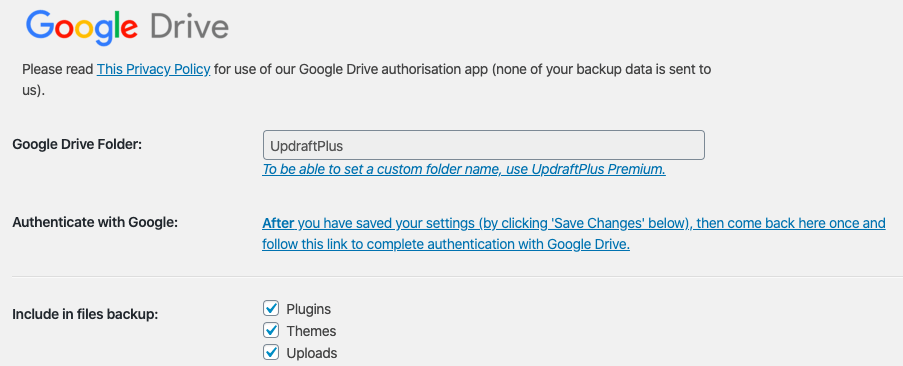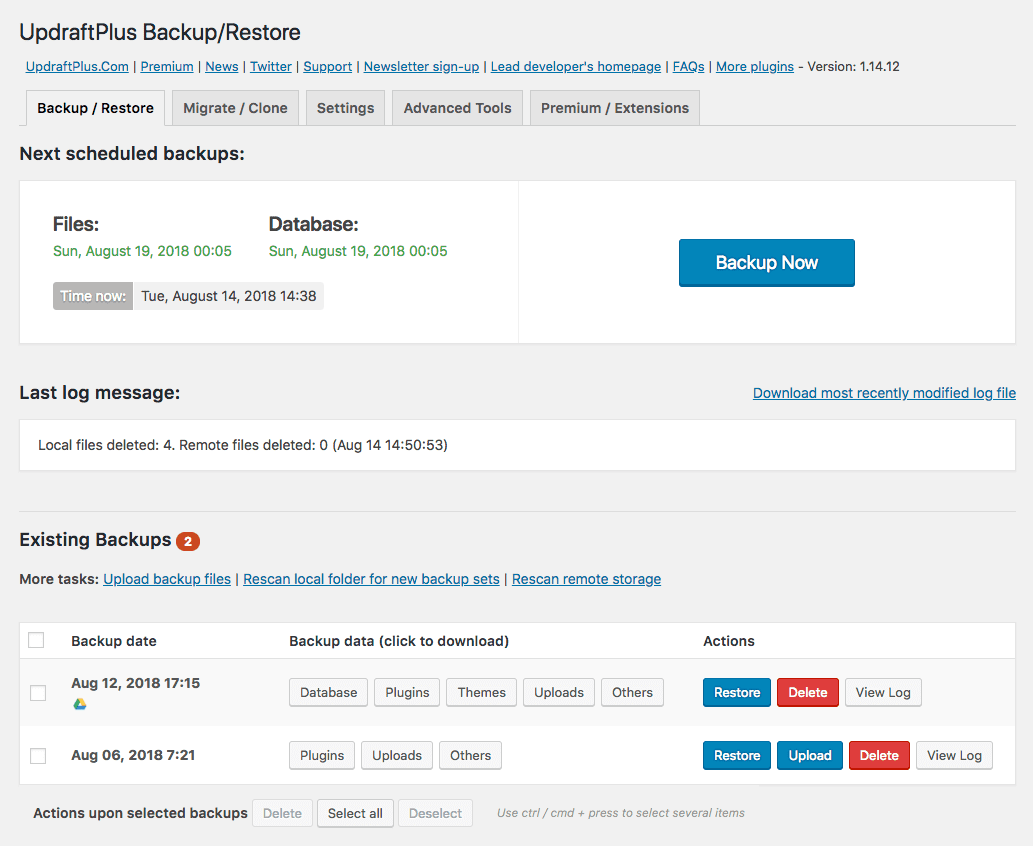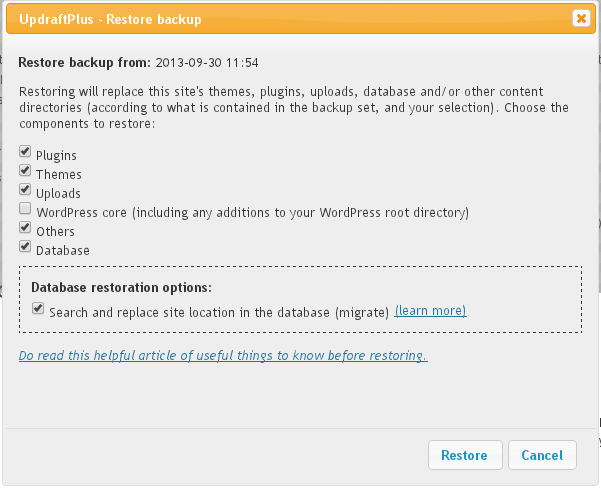No matter the size of your WordPress website, finding a way to keep it safe from issues such as updates gone wrong, hacking, user error and crashes should be of the utmost importance. If you’ve not set-up regular backups of your site yet, now’s the time to get it done, and it couldn’t be easier with the world’s most trusted WordPress backup plugin, UpdraftPlus.
In this article, we’re going to show you how to backup a WordPress site with an easy-to-use, free backup plugin. Follow our step-by-step tutorial below to get started.
UpdraftPlus allows you to backup your WordPress website and restore it with a single click. It also allows you to:
- Backup all of your WordPress files, databases, plugins and themes
- Set backup schedules every 4, 8 or 12 hours, daily, weekly, fortnightly or monthly
- Restore backups directly from your WordPress control panel
- Store your backups remotely on Google Drive, Dropbox, OneDrive and more
In this article, we’ll show you how to set-up and use UpdraftPlus to backup your WordPress website with ease so you can get on with more important stuff.
What does ‘backup’ mean?
Put simply, a ‘backup’ makes a copy of the files or data on your site in case the originals are lost or damaged.
A backup of your WordPress website makes a copy of your entire database. It will backup every post, comment and link you have on your site, as well as your plugins, themes and uploads.
Why you need to backup your WordPress site
Backing up your website regularly is an essential part of managing a WordPress website. Your site contains every post, comment and link you’ve ever created, if something were to go wrong, all of that could be lost in an instant.
Without performing vital backups, your site could be at risk from any of the following problems:
Updates gone wrong
WordPress websites are notorious for needing regular updates to plugin files, theme and WordPress itself.
When performing these updates, there’s a small chance your site could be negatively affected by the changes. You could lose vital functionality, your site’s look and feel could change, or the new update could simply be incompatible.
These updates need to be carried out to ensure the safety of your website and generally should be done on a testing site first. To protect your site from updates gone wrong, you should always carry out regular backups and automatic backups before each plugin update.
Your site is vulnerable to hacking
Due to the sheer number of people using WordPress as their content management system (it powers over 35% of all websites across the globe), the platform is the frequent target of hackers and spammers.
You may feel like your site is safe and will not be a target for hackers because as it doesn’t contain sensitive information, but hacks can happen for any of the following reasons:
- To spread malware
- Using your site to attack another site
- Spamming the internet with inappropriate links
- Just for fun
In order to work, hackers have to find flaws in a system and exploit them to get around security controls. So if you have a weak passwords, don’t update plugins regularly, have weak security on your site, your site could be at risk.
By backing up your site regularly, you can restore your site to its former pre-broken state before the hack took place.
Your hosting company may have server outages
No hosting company is perfect. In fact, you may have experienced your website ‘going down’ from time to time. This downtime (or server outage) can happen for a variety of reasons, including viruses and cyber hacking, traffic overload, hardware failure and more.
While you can’t control your hosting company’s server, you can protect your site if something happens. Many times, when server outages happen, your hosting company will be able to recover the lost files.
However, on some occasions, they will have to revert back to a version of your site that’s a few days old. This could mean you’d lose vital changes to your site such as sales records and new member registrations. The only way to recover these would be through your personal UpdraftPlus site backup.
How to backup your WordPress site with UpdraftPlus
The easiest and quickest way to backup your website is by using a WordPress backup plugin. UpdraftPlus is the world’s most trusted WordPress backup and restore plugin and is simple and easy to set-up.
How to install UpdraftPlus
Installing UpdraftPlus takes just a minute or two and is as simple as adding any other plugin. To install, follow these steps:
- In your WordPress dashboard go to Plugins > Add New.
- Type UpdraftPlus into the search bar.
- Find the UpdraftPlus WordPress Backup Plugin and press Install Now and then Activate.
How to use UpdraftPlus
Once installed, UpdraftPlus makes setting up your first WordPress backup easy. Simply follow these steps:
- Select Settings > UpdraftPlus Backups in your WordPress menu. This will open your UpdraftPlus settings page.
- Select the Settings tab at the top.
Here you can schedule how often UpdraftPlus creates a new backup. You can pick whichever schedule suits you and your site. For example, if you regularly update your site with new pages and posts, then a more frequent backup may be required.
You can also adjust how many of these backups should be stored at one time. Any new backups will then override the old ones.
- Select where you would like your backups to be stored.
Scroll down the page and you can choose where you’d like your files to be stored. UpdraftPlus can integrate with numerous remote storage options, so pick the one that suits you best.
- Once selected, each storage option will have its own set of instructions. Simply follow these and press the blue Save Changes button at the bottom of the page.
If you’d like to backup to more than one location or want to customise your backups further, you can do so by upgrading to UpdraftPremium. Or purchase the add-on, Multiple Storage Destinations.
Now that you’ve set up your storage location and how often you’d like to backup your site, UpdraftPlus will automatically carry out your first site backup without you having to do a thing.
How to restore your WordPress site from a backup
Now that your site is regularly backed up, you’re safe in the knowledge that you can recover and restore it if something goes wrong. So when the worst does happen, how do you restore your site with UpdraftPlus?
- Go to Settings > UpdraftPlus Backups in your WordPress menu. This again will open your UpdraftPlus settings page
- Scroll down the page until you reach the Existing Backups section
- Find the backup you want to restore and press the blue Restore button
- You’ll then be presented with a popup which will ask you which elements of your database you want to restore. Select the ones that apply and press Restore
When your restore is complete, a message will pop up telling you the restore has been successful.
Roundup
If you’re looking to keep your site safe from hacking, updates gone wrong and server crashes, then using a WordPress backup plugin is a must. As the world’s most trusted WordPress backup and restore plugin, UpdraftPlus allows you to do just this for free.
By investing in UpdraftPlus Premium, you also get the following added features:
- The ability to clone your site so you can carry out updates in a testing environment
- Schedule backups at specific times of the day to take advantage of when fewer people are on your site
- Multiple storage destinations for extra safety
- Detailed reports of your backups
- Password protection for your UpdraftPlus backups to keep other administrators out
- Automatic backups before updating WordPress core, themes and plugins
Get the best security for your website with the full UpdraftPlus package
The post How to Backup a WordPress Site: Step by Step Guide appeared first on UpdraftPlus. UpdraftPlus – Backup, restore and migration plugin for WordPress.

